Geology Reference
In-Depth Information
Nevertheless, the question still remained as to when
animals made the transition from water to land, and per-
haps even more intriguing is the question of why limbs
evolved in the first place? The answer to that question
is that it probably was not for walking on land. In fact,
many scientists think that aquatic limbs made it easier for
animals to move around in streams, lakes, or swamps that
were choked with water plants or other debris. The fossil
evidence that began to emerge in the 1990s also seems to
support this hypothesis.
Fossils of
Acanthostega
, a tetrapod found in 360-million-
year-old rocks from Greenland, reveals an animal that had
limbs, but was clearly unable to walk on land. Paleontologist
Jennifer Clack, who has recovered and analyzed hundreds of
specimens of
Acanthostega
, points out that
Acanthostega's
limbs were not strong enough to support its weight on land,
and its rib cage was too small for the necessary muscles
needed to hold its body off the ground. In addition,
Acan-
thostega
had gills and lungs, meaning that it could survive
on land, but it was more suited for the water. Clack thinks
that
Acanthostega
used its limbs to maneuver around in
swampy, plant-fi lled waters, where swimming would be dif-
fi cult and limbs were an advantage.
Fragmentary fossils from other tetrapods living at about
the same time as
Acanthostega
suggest, however, that some of these
early tetrapods may have spent more time on dry land than in
the water. These oldest amphibians, many of which are also
found in the Upper Devonian Old Red Sandstone of eastern
Greenland and belong to genera such as
Ichthyostega
, had
streamlined bodies, long tails, and fi ns along their backs. In
addition to four legs, they had a strong backbone, a rib cage,
and pelvic and pectoral girdles, all of which were structural
adaptations for walking on land (
◗
Figure 21.23
Similarities Between Crossopterygians and
Labyrinthodonts Similarities between the crossopterygian lobe-
fi nned fi sh and the labyrinthodont amphibians.
Labyrinthodont
Lobe fin
a
Skeletal similarity.
r
r
h
h
u
u
b
Comparison of the limb bones of a crossopterygian (
left
) and
amphibian (
right
); color identifi es the bones (u = ulna, shown in
blue; r = radius, mauve; h = humerus, gold) that the two groups
have in common.
Figure 21.24). These ear-
liest amphibians thus appear to have inherited many char-
acteristics from the crossopterygians with little modifi cation
(Figure 21.23). However, with the discovery of such fossils
as
Acanthostega
and others like it, the transition between fi sh
and amphibians involves a number of new genera that are
intermediary between the two groups.
In 2006, an exciting discovery of a 1.2-2.8-m-long,
375-million-year-old (Late Devonian) “fishapod” was an-
nounced. Discovered on Ellesmere Island, Canada,
Tiktaalik
roseae
, from the Inuktitut meaning “large fi sh in a stream,”
was hailed as an intermediary between the lobe-fi nned fi sh
and the earliest tetrapod,
Acanthostega
(
◗
Dentine
Pulp
cavity
Enamel
Figure 21.25).
Tiktaalik roseae
is truly a “fi shapod” in that it has a mix-
ture of both fi sh and tetrapod characteristics (Figure 21.25b).
For example, it has gills and fi sh scales, but also a broad skull,
eyes on top of its head, a fl exible neck and large rib cage that
could support its body on land or in shallow water, and
lungs, all of which are tetrapod features. What really excited
scientists, however, was that
Tiktaalik roseae
has the begin-
nings of a true tetrapod forelimb, complete with functional
wrist bones and fi ve digits, as well as a modifi ed ear region.
Sedimentological evidence suggests
Tiktaalik roseae
lived in
a shallow-water habitat associated with the Late Devonian
fl oodplains of Laurasia.
◗
c
Comparison of tooth cross sections shows the complex and
distinctive structure found in both the crossopterygians (
left
) and
labyrinthodont amphibians (
right
).
of oxygen from the atmosphere by lungs rather than from
water by gills. Up until the 1990s, the traditional evolutionary
sequence had a rhipidistian crossopterygian, like
Eusthenop-
teron
, evolving into a primitive amphibian like
Ichthyostega
.
At that time, fossils of those two genera were about all that
paleontologists had to work with, and although there were
gaps in morphology, the link between crossopterygians and
these earliest amphibians was easy to see (Figure 21.23).



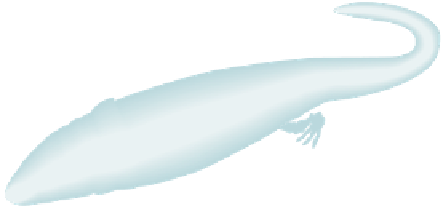









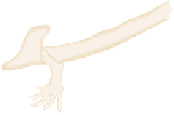




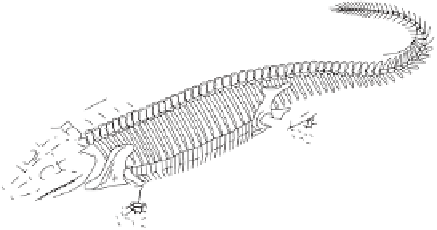
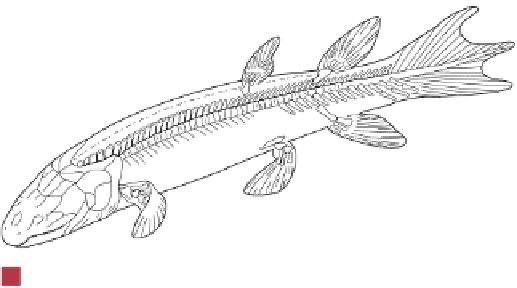









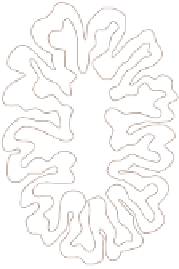

Search WWH ::

Custom Search